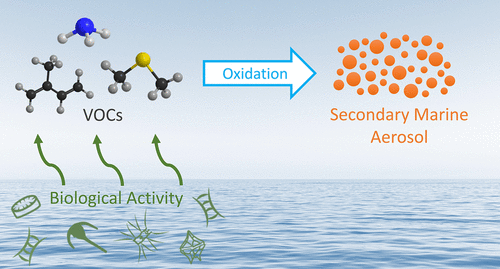当前位置:
X-MOL 学术
›
ACS Cent. Sci.
›
论文详情
Our official English website, www.x-mol.net, welcomes your
feedback! (Note: you will need to create a separate account there.)
Secondary Marine Aerosol Plays a Dominant Role over Primary Sea Spray Aerosol in Cloud Formation
ACS Central Science ( IF 12.7 ) Pub Date : 2020-11-25 , DOI: 10.1021/acscentsci.0c00793 Kathryn J. Mayer 1 , Xiaofei Wang 1, 2 , Mitchell V. Santander 1 , Brock A. Mitts 1 , Jonathan S. Sauer 1 , Camille M. Sultana 1 , Christopher D. Cappa 3 , Kimberly A. Prather 1, 4
ACS Central Science ( IF 12.7 ) Pub Date : 2020-11-25 , DOI: 10.1021/acscentsci.0c00793 Kathryn J. Mayer 1 , Xiaofei Wang 1, 2 , Mitchell V. Santander 1 , Brock A. Mitts 1 , Jonathan S. Sauer 1 , Camille M. Sultana 1 , Christopher D. Cappa 3 , Kimberly A. Prather 1, 4
Affiliation

|
Marine aerosols play a critical role in impacting our climate by seeding clouds over the oceans. Despite decades of research, key questions remain regarding how ocean biological activity changes the composition and cloud-forming ability of marine aerosols. This uncertainty largely stems from an inability to independently determine the cloud-forming potential of primary versus secondary marine aerosols in complex marine environments. Here, we present results from a unique 6-day mesocosm experiment where we isolated and studied the cloud-forming potential of primary and secondary marine aerosols over the course of a phytoplankton bloom. The results from this controlled laboratory approach can finally explain the long-observed changes in the hygroscopic properties of marine aerosols observed in previous field studies. We find that secondary marine aerosols, consisting of sulfate, ammonium, and organic species, correlate with phytoplankton biomass (i.e., chlorophyll-a concentrations), whereas primary sea spray aerosol does not. Importantly, the measured CCN activity (κapp = 0.59 ± 0.04) of the resulting secondary marine aerosol matches the values observed in previous field studies, suggesting secondary marine aerosols play the dominant role in affecting marine cloud properties. Given these findings, future studies must address the physical, chemical, and biological factors controlling the emissions of volatile organic compounds that form secondary marine aerosol, with the goal of improving model predictions of ocean biology on atmospheric chemistry, clouds, and climate.
中文翻译:

次级海洋气溶胶在云层形成中比主要海浪气溶胶起主导作用
海洋气溶胶通过在海洋上播种云层而在影响我们的气候方面发挥关键作用。尽管进行了数十年的研究,但有关海洋生物活动如何改变海洋气溶胶的组成和成云能力的关键问题仍然存在。这种不确定性很大程度上是由于无法独立确定复杂海洋环境中主要和次要海洋气溶胶的成云潜力。在这里,我们展示了一个独特的为期6天的中观宇宙实验的结果,我们在浮游植物开花过程中分离并研究了主要和次要海洋气溶胶的云形成潜力。这种受控实验室方法的结果最终可以解释长期以来在以前的田间研究中观察到的海洋气溶胶吸湿特性的变化。我们发现,由硫酸盐,铵盐和有机物组成的次级海洋气溶胶与浮游植物生物量(即叶绿素-a浓度)相关,而初级海浪气溶胶则不相关。重要的是,测得的CCN活性(κapp = 0.59±0.04)产生的次级海洋气溶胶与先前实地研究中观察到的值匹配,这表明次级海洋气溶胶在影响海洋云的性质中起着主导作用。鉴于这些发现,未来的研究必须解决控制形成次级海洋气溶胶的挥发性有机化合物排放的物理,化学和生物学因素,其目标是改善海洋生物学对大气化学,云和气候的模型预测。
更新日期:2020-12-23
中文翻译:

次级海洋气溶胶在云层形成中比主要海浪气溶胶起主导作用
海洋气溶胶通过在海洋上播种云层而在影响我们的气候方面发挥关键作用。尽管进行了数十年的研究,但有关海洋生物活动如何改变海洋气溶胶的组成和成云能力的关键问题仍然存在。这种不确定性很大程度上是由于无法独立确定复杂海洋环境中主要和次要海洋气溶胶的成云潜力。在这里,我们展示了一个独特的为期6天的中观宇宙实验的结果,我们在浮游植物开花过程中分离并研究了主要和次要海洋气溶胶的云形成潜力。这种受控实验室方法的结果最终可以解释长期以来在以前的田间研究中观察到的海洋气溶胶吸湿特性的变化。我们发现,由硫酸盐,铵盐和有机物组成的次级海洋气溶胶与浮游植物生物量(即叶绿素-a浓度)相关,而初级海浪气溶胶则不相关。重要的是,测得的CCN活性(κapp = 0.59±0.04)产生的次级海洋气溶胶与先前实地研究中观察到的值匹配,这表明次级海洋气溶胶在影响海洋云的性质中起着主导作用。鉴于这些发现,未来的研究必须解决控制形成次级海洋气溶胶的挥发性有机化合物排放的物理,化学和生物学因素,其目标是改善海洋生物学对大气化学,云和气候的模型预测。









































 京公网安备 11010802027423号
京公网安备 11010802027423号